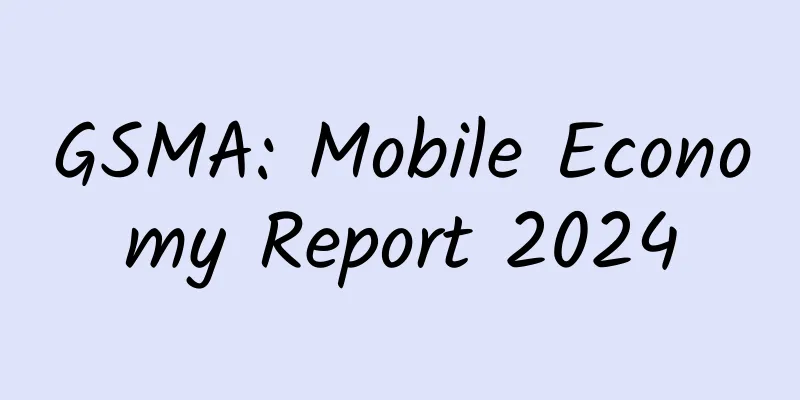GSMA: Mobile Economy Report 2024

|
GSMA released the "Mobile Economy Report 2024". Mobile connectivity remains key to driving digital innovation. It enables a wide range of transformative technologies for individuals and businesses, while also helping governments to have a positive social impact. By the end of 2023, 5.6 billion people (69% of the global population) subscribe to mobile services, an increase of 1.6 billion since 2015. Mobile internet penetration grows even faster. By the end of 2023, 58% of the global population uses mobile internet, equivalent to 4.7 billion users, an increase of 2.1 billion since 2015. In 2023, mobile technology and services will account for 5.4% of global GDP, with an economic added value of US$5.7 trillion and provide approximately 35 million jobs. Key trends shaping the mobile ecosystem 5G Standalone and 5G Advanced are the next phase The mobile industry is increasingly turning to 5G SA and 5G-Advanced standards to unlock innovative 5G use cases and create new revenue streams. As of January 2024, 47 operators offer commercial 5G services on SA networks. Web API initiatives gain traction Although network APIs have been exposed for some time, operators have struggled to adopt a standardized approach to achieve scale. The recent development of a common set of network APIs in the mobile industry has provided new impetus for operators. As of January 2024, 47 operators are expected to offer commercial 5G services on SA networks, with more than half expecting to deploy 5G-Advanced within a year of the standard being released. Telecom satellite cooperation is about to begin Telecommunications networks have enabled voice and data connectivity to unprecedented levels, with more than 4.7 billion mobile internet users today. Satellite and other non-terrestrial networks (NTNs) have also been providing connectivity, but on a much smaller scale. eSIM adoption gathers pace The number of eSIM consumer devices launched in the past five years has grown significantly, and the number of commercial eSIM services is also rising. This lays the foundation for SIM adoption in the next decade. GSMA predicts that by the end of 2025, there will be about 1 billion eSIM smartphone connections worldwide, growing to 6.9 billion by 2030. By 2030, it will account for about 3/4 of the total smartphone connections. North America will be the fastest region for eSIM adoption as Apple will launch an eSIM-only smartphone in the United States in September 2022. Exploring the potential of generative AI For mobile operators, the scope of Generative Artificial Intelligence (GenAI) applications is wide-ranging. Much of the early work has focused on using this technology to improve customer service and support sales and marketing activities. As AI matures, operators will be able to support not only internal use cases but also generate new revenue from their investments. Growth and innovation policies The 2023 World Radiocommunication Conference (WRC-23) sets out the spectrum planning agenda through to the end of the 2030s, which includes the coordination of new spectrum in the low- and mid-frequency bands. |
<<: Understand at a glance: 9 “pitfall-avoiding” guidelines for COVID-19 medication!
Recommend
Basic research report on mobile social behavior of post-90s in second-tier cities
Post-90s, a word that is familiar yet unfamiliar ...
Cervical dilation surgery
There are many cervical diseases clinically, whic...
Sudden frequent fetal movements in late pregnancy
Sometimes people become more sensitive and anxiou...
The discharge diagram of compound zedoaria oil suppository
Different medicines have different effects on tre...
How to regulate menstruation always in advance
There are many symptoms of irregular menstruation...
How to treat high estrogen levels? These methods are very effective
If a woman goes for a check-up and finds that her...
Why do I always feel sleepy during late pregnancy?
Pregnancy is a very long process. During this pro...
What to do if I always have bleeding during ovulation
Ovulation bleeding is a common problem among fema...
It's the ninth day of menstruation and it's still not clean
We all know that almost every woman will have men...
A brief discussion on the significance of social network data analysis
With the rapid development of information technol...
Treatment of leucorrhea in pregnant women
Many pregnant mothers do not pay great attention ...
How to judge the size of the belly at 11 weeks of pregnancy
For many expectant mothers, their bellies will gr...
After a woman's ovaries become diseased, her private parts will become thicker
When beauties first consider weight loss methods ...
How to treat itchy athlete's foot during pregnancy
In real life, some female friends will get athlet...
Five "special areas" of a woman's body: A "dirtier" belly button is healthier
In traditional Chinese medicine, observation, aus...









